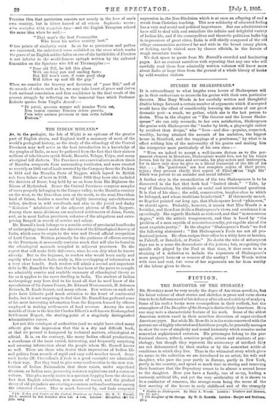THE INDIAN MIDLAND.* As, to the geologist, the Isle of
Wight is an epitome of the greater part of English strata, and England itself a summary of most of the world's geological history, so the study of the ethnology of the Central Provinces may well serve as the best introduction to a knowledge of the peoples of India, as may be gathered from the fact that their sixteen millions of inhabitants speak Hindi, Marathi, Telugu, Uriya, and many aboriginal hill dialects. The Provinces area survival into modern times of Maratha conquests from surrounding territories, and were created Bo recently as 1861 out of lands wrested by the Company from the Peshwa, in 1818 and the Maratha State of Nagpur, which lapsed to British rule from failure of heirs in 1853. Since 1903 they have also included the districts of Berar, long held by us on lease from His Highness the Nizam of Hyderabad. Hence the Central Provinces comprise samples of races properly belonging to the Ganges valley, to the Maratha country on the west, to the Dravidian area on the south, to the semi-Dravidian land of Orissa, besides a number of highly interesting autochthonous tribes, dwellers in wild woodlands and akin to the jovial and dusky " Kolarian " inhabitants of the adjacent plateau of Chota Nagpore. Among these main divisions are scattered settlements of Jains, Parsis, and, as in most Indian provinces, colonies of the ubiquitous and enter- prising Bengali in search of service and salary.
Mr. Russell's book belongs to a notable series of provincial handbooks of anthropology issued under the direction of the Ethnological Survey of India, which owes its origin to the wise and liberal official recognition of Lord Curzon. Written primarily for the guidance of officers serving in the Provinces, it necessarily contains much that will also be found in the ethnological manuals compiled in adjacent provinces. To the expert that will make little difference, since he can skip what he knows already. But to the beginner, to readers who would learn easily and rapidly what modern India really is, this overlapping of information is a very clear benefit. Such readers will admit a second and important debt to Mr. Russell for the fact that he has been at the pains to compile an admirably concise and readable summary of ethnological theory so far as it applies to the races dwelling in India. The student of Indian anthropology may here find to his hand all that he need know of the speculations of Sir James Frazer, Dr. Edward Westermarck, M. Salomon Reinach, M. Emile Senart, and many others. Few writers on such sub- jects have hitherto paid much attention to the heart of continental India, but it is not surprising to find that Mr. Russell has gathered some of his most interesting information from the Reports framed by officers employed in making settlements of land revenue. Among the most notable of these is the late Sir Charles Elliott's well-known Hoshangabad Settlement Report, the starting-point of a singularly distinguished administrative career.
Let not this catalogue of authorities (and we might have cited many others) give the impression that this is a dry and difficult book, or that its perusal is hampered by technical matters, ethnological or officiaL It is, on the contrary, like many Indian official productions, a storehouse of the most varied, interesting, and frequently surprising and amusing information about the people whom Mr. Russell knows so well. There are those who derive their impressions of Indian life and polities from records of rapid and easy cold-weather travel. Some such books (11f. Chevrillon's L'Inde is a good example) are admirable i t their way. But they tend to give some confirmation to the new con- tention of Indian Nationalists that there exists, under superficial divisions, an Indian race, possessing common aspirations and a common culture. This plea merely states in a question-begging form the obvious fact that English education, new means of travel, and the gradual decay of old prejudices arc creating a common national sentiment among the educated classes. This is much fostered by, and finds congenial • Th. Tribes and Castes of the Central Provinces of India. By R. V. Russell, l.C.S., assisted by Rai Bahadur Itixa Lal. 4 vols. London: Macmillan Di Co. [42s. net.' expression in, the Neo-Hinduism which is at once an offspring of and a revolt from Christian teaching. This new solidarity of educated feeling has a very real social and political importance. But our administrators have still to deal with and assimilate the infinite and delightful variety of Indian life, and if the cosmopolitan and theoretic politician bulks big in impressions of great cities, India is still chiefly composed of the old village communities scattered far and wide in the broad sunny plains, or lurking, rarely visited save by chance officials, in the forests of rough mountain tracts.
We lack space to quote from Mr. Russell's crowded and fascinating pages. Let us content ourselves with repeating that any one who will carefully read these four admirably written volumes will know more about India at large than from the perusal of a whole library of books by cold-weather visitors.










































 Previous page
Previous page